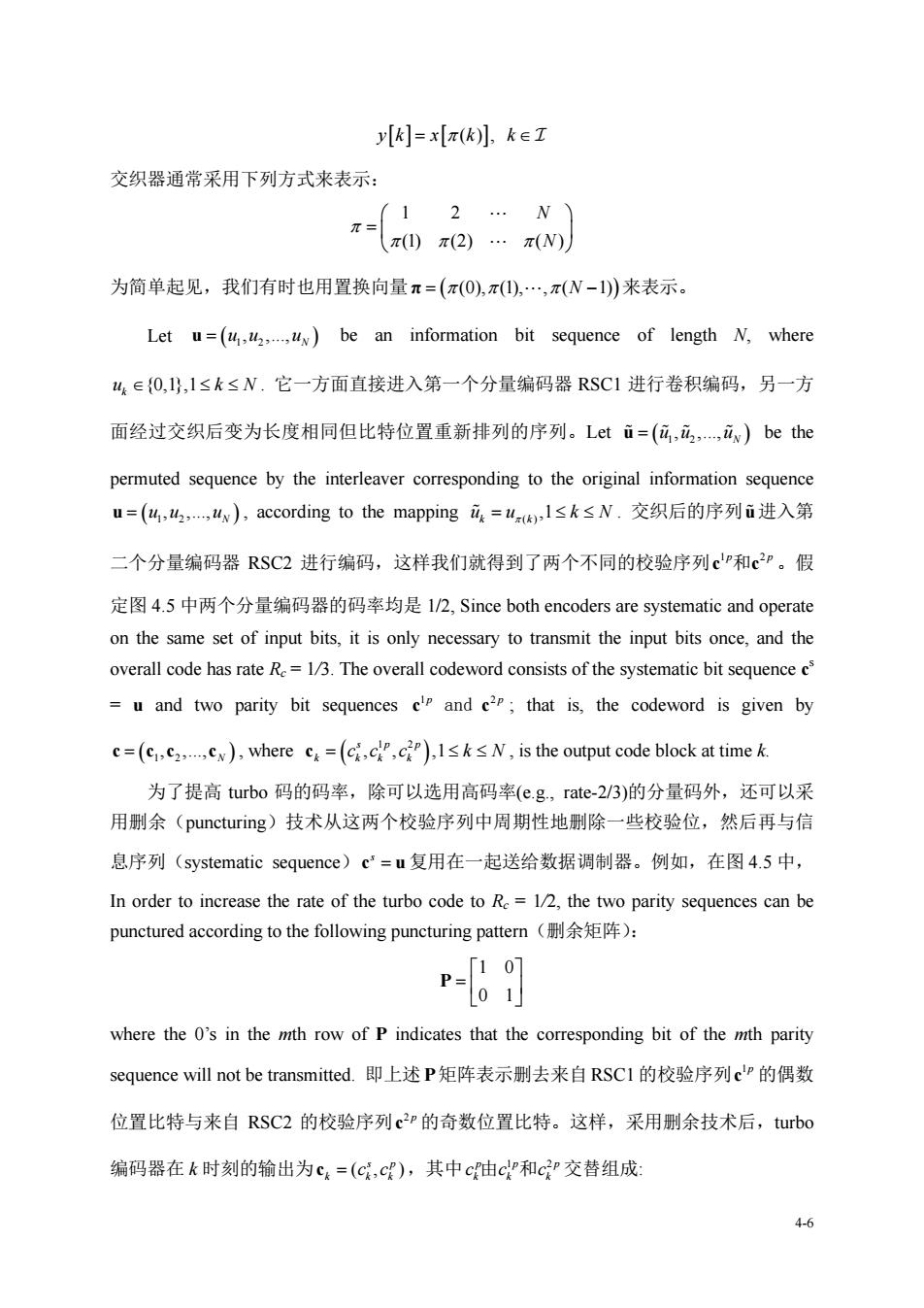正在加载图片...

y[k]=x[π(k)小,keT 交织器通常采用下列方式来表示: 00 为简单起见,我们有时也用置换向量π=(π(O),π(,.,π(N-)来表示。 Let u=(u)be an information bit sequence of length N,where 4:∈0,1,1≤k≤N,它一方面直接进入第一个分量编码器RSC1进行卷积编码,另一方 面经过交织后变为长度相同但比特位置重新排列的序列。Lti=(a,立,iv)be the permuted sequence by the interleaver corresponding to the original information sequence u=(4,4,x),according to the mappingi立=4k,l≤k≤N.交织后的序列i进入第 二个分量编码器RSC2进行编码,这样我们就得到了两个不同的校验序列cP和2P。假 定图4.5中两个分量编码器的码率均是l/2,Since both encoders are systematic and operate on the same set of input bits,it is only necessary to transmit the input bits once,and the overall code has rate R=13.The overall codeword consists of the systematic bit sequencee -u and two parity bit sequences c'and c;that is,the codeword is given by c=(c).wherec=(N.is the output code block at time 为了提高turbo码的码率,除可以选用高码率(e.g,rate-2/3)的分量码外,还可以采 用删余(puncturing)技术从这两个校验序列中周期性地删除一些校验位,然后再与信 息序列(systematic sequence)c=u复用在一起送给数据调制器。例如,在图4.5中, In order to increase the rate of the turbo code to R=1/2,the two parity sequences can be punctured according to the following puncturing pattern(别余矩阵): where the 0's in the mth row of P indicates that the corresponding bit of the mth parity sequence will not be transmitted.即上述P矩阵表示别去来自RSCl的校验序列c'P的偶数 位置比特与来自RSC2的校验序列c2P的奇数位置比特。这样,采用别余技术后,turbo 编码器在k时刻的输出为c,=(G,c),其中c由和c”交替组成: 4-64-6 yk x k k ( ) , 交织器通常采用下列方式来表示: 1 2 (1) (2) ( ) N N 为简单起见,我们有时也用置换向量π (0), (1), , ( 1) N 来表示。 Let 1 2 , ,., N u uu u be an information bit sequence of length N, where {0,1},1 k u kN . 它一方面直接进入第一个分量编码器 RSC1 进行卷积编码,另一方 面经过交织后变为长度相同但比特位置重新排列的序列。Let u uu u 1 2 , ,., N be the permuted sequence by the interleaver corresponding to the original information sequence 1 2 , ,., N u uu u , according to the mapping ( ) ,1 k k u u kN . 交织后的序列u 进入第 二个分量编码器 RSC2 进行编码,这样我们就得到了两个不同的校验序列 1 2 p p c c 和 。假 定图 4.5 中两个分量编码器的码率均是 1/2, Since both encoders are systematic and operate on the same set of input bits, it is only necessary to transmit the input bits once, and the overall code has rate Rc = 1/3. The overall codeword consists of the systematic bit sequence c s = u and two parity bit sequences 1 2 p p c c and ; that is, the codeword is given by 1 2 , ,., N c cc c , where 1 2 , , ,1 sp p k kk k c cc c k N , is the output code block at time k. 为了提高 turbo 码的码率,除可以选用高码率(e.g., rate-2/3)的分量码外,还可以采 用删余(puncturing)技术从这两个校验序列中周期性地删除一些校验位,然后再与信 息序列(systematic sequence) s c u 复用在一起送给数据调制器。例如,在图 4.5 中, In order to increase the rate of the turbo code to Rc = 1/2, the two parity sequences can be punctured according to the following puncturing pattern(删余矩阵): 1 0 0 1 P where the 0’s in the mth row of P indicates that the corresponding bit of the mth parity sequence will not be transmitted. 即上述 P 矩阵表示删去来自 RSC1 的校验序列 1p c 的偶数 位置比特与来自 RSC2 的校验序列 2 p c 的奇数位置比特。这样,采用删余技术后,turbo 编码器在 k 时刻的输出为 (, ) s p k kk c c c ,其中 pp p 1 2 kk k cc c 由 和 交替组成: